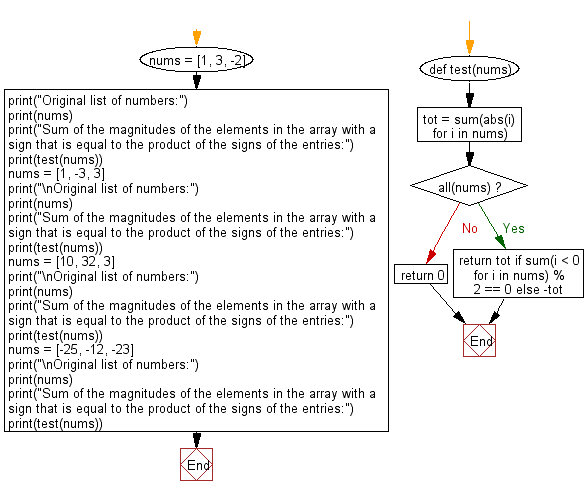Python: Sum of the magnitudes of the elements in the array with product signs
Signed Sum of Magnitudes
Write a Python program to find the sum of the magnitudes of the elements in the array. This sum should have a sign that is equal to the product of the signs of the entries.
Input: [1, 3, -2] Output: -6 Input: [1, -3, 3] Output: -7 Input: [10, 32, 3] Output: 45 Input: [-25, -12, -23] Output: -60
Visual Presentation:

Sample Solution:
Python Code:
# Define a function named 'test' that takes a list of numbers as a parameter
def test(nums):
# Calculate the total sum of the magnitudes of the elements in the array
tot = sum(abs(i) for i in nums)
# Check if all elements in the array are non-zero
if all(nums):
# Return the total sum with a positive or negative sign based on the product of the signs of the entries
return tot if sum(i < 0 for i in nums) % 2 == 0 else -tot
# If there is a zero element in the array, return 0
return 0
# Set a list of numbers as the input for the test function
nums = [1, 3, -2]
# Print a message indicating the original list of numbers
print("Original list of numbers:")
# Print the original list of numbers
print(nums)
# Print a message indicating the task and the result of the test function
print("Sum of the magnitudes of the elements in the array with a sign that is equal to the product of the signs of the entries:")
# Print the result of the test function applied to the given list of numbers
print(test(nums))
# Set a new list of numbers as the input for the test function
nums = [1, -3, 3]
# Print a message indicating the original list of numbers
print("\nOriginal list of numbers:")
# Print the original list of numbers
print(nums)
# Print a message indicating the task and the result of the test function
print("Sum of the magnitudes of the elements in the array with a sign that is equal to the product of the signs of the entries:")
# Print the result of the test function applied to the new list of numbers
print(test(nums))
# Set another new list of numbers as the input for the test function
nums = [10, 32, 3]
# Print a message indicating the original list of numbers
print("\nOriginal list of numbers:")
# Print the original list of numbers
print(nums)
# Print a message indicating the task and the result of the test function
print("Sum of the magnitudes of the elements in the array with a sign that is equal to the product of the signs of the entries:")
# Print the result of the test function applied to the new list of numbers
print(test(nums))
# Set yet another new list of numbers as the input for the test function
nums = [-25, -12, -23]
# Print a message indicating the original list of numbers
print("\nOriginal list of numbers:")
# Print the original list of numbers
print(nums)
# Print a message indicating the task and the result of the test function
print("Sum of the magnitudes of the elements in the array with a sign that is equal to the product of the signs of the entries:")
# Print the result of the test function applied to the new list of numbers
print(test(nums))
Sample Output:
Original list of numbers: [1, 3, -2] Sum of the magnitudes of the elements in the array with a sign that is equal to the product of the signs of the entries: -6 Original list of numbers: [1, -3, 3] Sum of the magnitudes of the elements in the array with a sign that is equal to the product of the signs of the entries: -7 Original list of numbers: [10, 32, 3] Sum of the magnitudes of the elements in the array with a sign that is equal to the product of the signs of the entries: 45 Original list of numbers: [-25, -12, -23] Sum of the magnitudes of the elements in the array with a sign that is equal to the product of the signs of the entries: -60
Flowchart:

For more Practice: Solve these Related Problems:
- Write a Python program to compute the sum of absolute values of a list and then assign the overall sign based on the product of the original signs.
- Write a Python program to separate positive and negative numbers, sum their magnitudes, and multiply by -1 if an odd number of negatives exists.
- Write a Python program to use functional programming to calculate the signed sum where the sign is determined by the product of signs.
- Write a Python program to iterate over a list, sum the absolute values, and then adjust the final result’s sign based on the cumulative sign product.
Go to:
Previous: Find an integer exponent x such that a^x = n.
Next: Biggest even number between two numbers inclusive.
Python Code Editor :
Have another way to solve this solution? Contribute your code (and comments) through Disqus.
What is the difficulty level of this exercise?
Test your Programming skills with w3resource's quiz.
